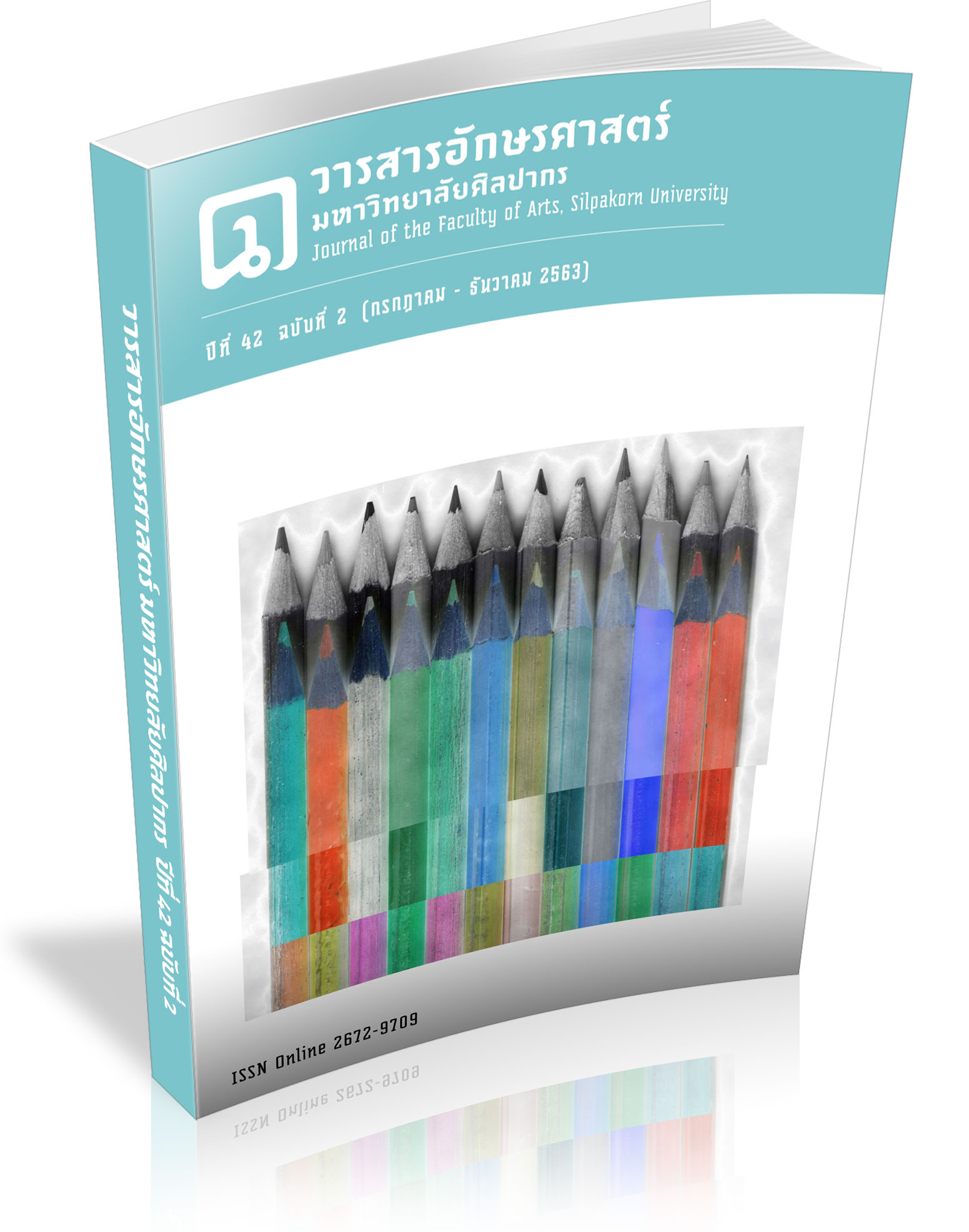Locative Particles (ni, de, o) Learning Achievement and Application of Japanese Learners Taught with Direct Instruction
Keywords:
locative particles (ni, de, o), direct instruction, cognitive domainAbstract
The objectives of this research are to 1) study and understand whether second year students having completed the direct instruction courses Basic Japanese I to IV at the Faculty of Arts, Silpakorn University are able to use locative particles, namely ni, de, and o, correctly according to Bloom’s taxonomy cognitive domain; 2) study the differences in the thinking processes of using locative particles at ‘remembering’, ‘understanding’, and ‘applying’ levels using statistical tests; and 3) optimize the teaching methods of Basic Japanese I to IV. The results show 1) the direct instruction teaching method used in Basic Japanese I to IV is rather effective for students to use locative particles at memorization level; 2) the average in each section differs significantly by a level 0.05 based on the statistical analysis, using F-test and ANOVA, of the student’s answers in each section of the test; and 3) the enhancement of students’ cognitive processes in choosing locative particles and their self-assessment of errors. This could be beneficial for improving the teaching methods in Basic Japanese I to IV.
Downloads
References
Bloom, B., Englehart, M. Furst, E., Hill, W., & Krathwohl, D. (1956). Taxonomy of educational objectives: The classification of educational goals. Handbook I: Cognitive domain. New York, Toronto: Longmans, Green.
Chanchay, S., Thongkamkaew, A. & Naphatthalung, N. (2014). Ability in Reading Comprehension and Written Communication of the First Grade Students by Using Direct Instruction with Graphic Organizers. Journal of Education, Prince of Songkla University, 25 (1), 72-81.
Chawengkitwanich, S. (2013). On The Use of Japanese Praticles Showing Location ‘ni’ and ‘de’ of Thai Learners. Japanese Studies Journal, 30 (2), 75-93. (In Thai)
Jongsutjarittam, P. (2006). A Study on the Error Rate of Particles of University Entrance Examination. The Japan Foundation Bangkok Japanese Culture Center Bulletin of Japanese Education, (3), 53-64. (In Thai)
Joyce, B., & Marcha, Wl. (1996). Model of Teaching. 4TH ed. Englewood Cliffs, NJ : Prentice-Hall.
Kamimura, F. (2003). On L2 Learners’Acquisition of Japanese Particle “ni”. Ariake : Kumamoto University linguistic papers, 2, 151-170. (In Japanese)
Khammani, T. (2017). Science of teaching Pedagogy: Knowledge in order to provide an effective learning process. 21st ed. Bangkok: Chulalongkorn University Press. (In Thai)
Na ranong, S. (2003). Study on grammatical errors in elementary and intermediate Japanese composition writing of Thai students: Problems in using particles. Proceedings of 41th Kasetsart University Annual Conference: Education, Social Sciences, Economics, Business Administration, Home Economics, Humanities, pp.448-455, Bangkok, Kasetsart University. (In Thai)
Okada, M., & Hayashida, M. (2016). Acquistition of the Goal Particle ni and the Active Particle de by Intermediate Level Chinese-Speaking Japanese Learners. Nihongokyouiku, (163), 48-63. (In Japanese)
Pradubwate, R. (2017). Technology Learning Management Guidelines by using Bloom's taxonomy. Veridian E-Journal, Silpakorn University (Humanities, Social Sciences and Arts, 10 (3), 1051-1065.
Promratana, P.L. (2015). Developing Question-Asking Skills Based on the Concept of Bloom’s Taxonomy for Designing Achievement Test. Retrieved 1 May 2020, from http ://www.educathai.com/upload/content/file_1447182498.pdf. (In Thai)
Sakoda, K. (2001). A Language Processing Strategy that Produces Learners' Errors : The Case of 'NI' and 'DE' Showing Location. Bulletin of the Department of Teaching Japanese as a Second Language, Hiroshima University, (11), 17-22. (In Japanese)
Shimada, K. (2011). Analysis of misuse of learners of Japanese-A case study of native Chinese speakers. Yamaguchi Kokubun, (34), 96-106. (In Japanese)
Yamaguchi, K. (2017). On the characteristics of sentences in which overuse of "ni" appeared in the composition of beginner learners, Academia. Literature and language, (101), 169-184. (In Japanese)
Downloads
Published
How to Cite
Issue
Section
License
ผู้เขียนบทความต้องยินยอมในข้อกำหนดต่าง ๆ ของวารสารก่อนส่งบทความตีพิมพ์




